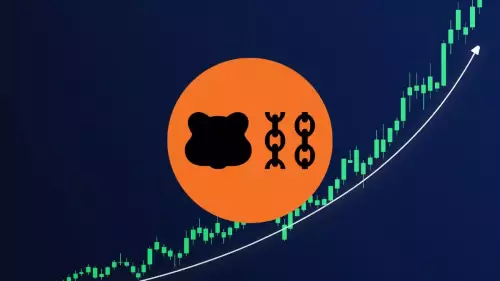 |
|
 |
|
 |
|
 |
|
 |
|
 |
|
 |
|
 |
|
 |
|
 |
|
 |
|
 |
|
 |
|
 |
|
 |
|
Cryptocurrency News Articles
How to Simulate a Uniswap V3 Order Book in Python | by Ian Moore, PhD | May, 2024 | DataDrivenInvestor
May 15, 2024 at 11:37 am
This article explores the simulation of a Uniswap V3 liquidity pool and order book using DeFiPy, a Python suite for DeFi. Through simulated price data from a Geometric Brownian Motion process, a Uniswap V3 pool is set up using the key components of UniswapPy, a Python package for Uniswap V2/V3 operations. The simulation includes events of liquidity adjustments, swaps, and data capture, with visualizations of LP parameters and order book distribution. The simulated order book is constructed from tick data, providing insight into the demand and supply of assets at different prices. The simulation setup facilitates further research in DeFi, including the behavior of advanced systems, analysis of impermanent loss, and risk profiling for new protocols.

Simulating a Uniswap V3 Order Book in Python: A Guide for Informed Market Analysis
Introduction
Automated market makers (AMMs) play a pivotal role in decentralized exchanges (DEXs), facilitating peer-to-peer trading without the need for intermediaries. Uniswap, a pioneering DEX, introduced Uniswap V3 in May 2021, revolutionizing the AMM landscape with its concentrated liquidity market maker (CLMM) protocol. This upgrade addressed inefficiencies in liquidity distribution, leading to enhanced returns for liquidity providers.
Background: Uniswap V3 Concentrated Liquidity
The CLMM protocol introduced by Uniswap V3 concentrates liquidity within the active trading band, effectively deepening the order book and making more liquidity available for trading. This optimization addresses the problem of lazy liquidity, where funds are inefficiently distributed across all price levels, resulting in potential slippage and less efficient trading.
Simulating Asset Prices Using Brownian Motion
To simulate realistic market conditions, we utilize Brownian motion, a stochastic process widely used in modeling financial phenomena. By employing a Geometric Brownian Motion (GBM) process, we can generate asset price data with controllable drift and volatility attributes. This approach allows for experimentation with various market scenarios.
Setting Up the Uniswap V3 Pool
Using the DeFiPy Python suite, we create a simulated Uniswap V3 pool. This framework provides essential components such as liquidity factory, join processes, and helper functions for calibrating tick intervals based on price inputs. The liquidity pool is initialized with a user-defined fee, token pair, and tick spacing.
Simulating Liquidity Pool Dynamics
The simulation comprises a series of events that mimic real-world market activity. These events include:
- Recalculating pool reserves: Adjusting reserves to reflect market price changes
- Determining tick intervals: Updating tick intervals based on price fluctuations
- Adding liquidity: Randomly depositing tokens into the pool to maintain liquidity
- Swapping tokens: Simulating token swaps with random amounts and directions
- Data capture: Collecting metrics such as pool prices, liquidity, and swap volumes
Constructing Order Book
An order book is a record of open buy and sell orders, providing insights into market supply and demand. We construct an order book from the tick data obtained during the liquidity pool simulation. The process involves:
- Extracting tick positions and corresponding liquidity values
- Converting tick positions to prices
- Sorting the liquidity positions by price
- Categorizing tick positions into bids (lower than center) and asks (higher than center)
Reviewing Output: Scatterplot and Depth Chart
The constructed order book data is visualized using a scatterplot, displaying the relationship between token price and liquidity. This visualization helps identify areas of high and low liquidity at different price levels.
Additionally, we generate a depth chart, a representation of the distribution of liquidity across price levels. The depth chart allows for analysis of market demand and supply. By observing the depth chart, traders can make informed decisions about optimal trade prices and order sizes to minimize slippage.
Summary and Applications
This simulation provides a framework for analyzing the behavior of Uniswap V3 liquidity pools and order books. The insights gained can be used for:
- Evaluating liquidity distribution and market efficiency
- Studying the impact of impermanent loss on liquidity providers
- Analyzing the risk-return profile of liquidity pools
- Optimizing trading strategies to minimize slippage and maximize returns
The code for this simulation is available on the DeFiPy GitHub repository.
Disclaimer:info@kdj.com
The information provided is not trading advice. kdj.com does not assume any responsibility for any investments made based on the information provided in this article. Cryptocurrencies are highly volatile and it is highly recommended that you invest with caution after thorough research!
If you believe that the content used on this website infringes your copyright, please contact us immediately (info@kdj.com) and we will delete it promptly.



















![The Graph Price Prediction [GRT Crypto Price News Today] The Graph Price Prediction [GRT Crypto Price News Today]](/uploads/2025/11/07/cryptocurrencies-news/videos/690d4df44fe69_image_500_375.webp)










































